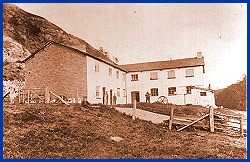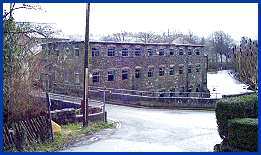
Llanidloes - the flannel makers
11
The end of an industry
As the Industrial Revolution advanced in the mill-towns of northern England, the woven textile industry of Montgomeryshire was less and less able to compete for a share of the same home and overseas markets. The huge textile mills of Lancashire and Yorkshire had the advantages of much greater capital investment, good rail, canal and road links, and the benefits of large scale production.
Photograph by
kind permission of
Cyrus Meredith
 The
coming of the railways in the 1860's, which some had hoped would
be the turning point in the fortunes of the industry by providing
greatly improved access to markets, resulted instead in a flow
in the other direction. The extended railway links made it easier
for the mass produced textiles of the northern mill towns to
flood the markets, including the local ones in Wales. The former
woollen mill (above) at Tylwch,
a few miles south of Llanidloes, was sited between the new railway
track and the River Dulas.
The
coming of the railways in the 1860's, which some had hoped would
be the turning point in the fortunes of the industry by providing
greatly improved access to markets, resulted instead in a flow
in the other direction. The extended railway links made it easier
for the mass produced textiles of the northern mill towns to
flood the markets, including the local ones in Wales. The former
woollen mill (above) at Tylwch,
a few miles south of Llanidloes, was sited between the new railway
track and the River Dulas.The former
Bridgend Factory,
Llanidloes
 There are
now few reminders of the former scale of the flannel industry
in and around Llanidloes, since few of the larger buildings have
survived.
There are
now few reminders of the former scale of the flannel industry
in and around Llanidloes, since few of the larger buildings have
survived.The recent photograph (left) is of the former Bridgend Factory near the Short Bridge over the River Severn.
It was built in 1834 to harness water power, with a carding engine on the ground floor and spinning mules and looms on the upper floors. The Bridgend Factory was the last of the Llanidloes flannel mills to close.
There are 11 pages on the flannel industry. Use the box links below to view the other pages.